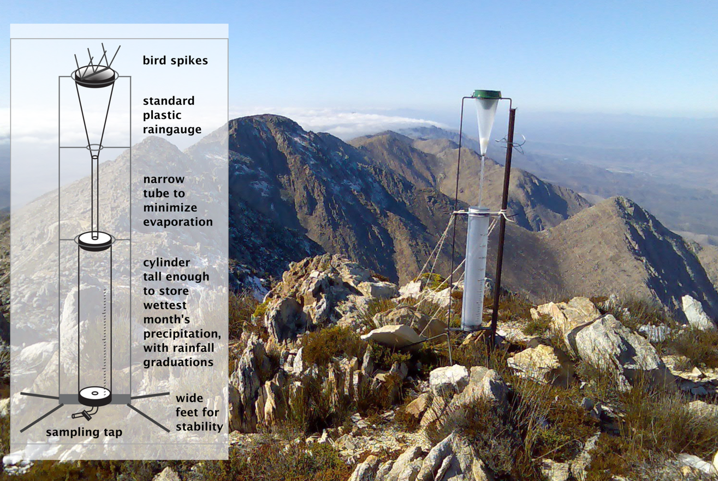8.2 Precipitation
From a hydrogeological perspective, the main reason to sample precipitation is to better understand recharge. The isotope composition of precipitation provides an input value for water cycle or catchment related studies. The isotope composition of recharge may differ from that of precipitation, primarily due to evaporation during infiltration, however, knowing the original precipitation value is useful for many applications.
8.2.1 Spatial and Temporal Variation in Precipitation
Precipitation varies isotopically over time and space. Spatial variation increases with the size of the study area, the climatic complexity (erratic precipitation or multiple types of weather systems) and terrain complexity (mainly altitude change). It is the responsibility of the investigator to ensure capture of such variation. Temporal variation occurs by the minute in rain events (Muller et al., 2015) as well as over many years (Diamond and Harris, 2019). The more completely that all of the rain is captured and the longer the period of sampling (years to decades), the more accurate the average isotope composition. Over decades of sampling, climate change is likely to have an impact so long-term averages may reflect rising or falling trends, rather than steady means.
Sampling of precipitation can be challenging. The ultimate goal is to capture all precipitation that would otherwise have fallen on the ground and to measure how much fell, according to local or internationally accepted measurement methods (Bosman, 1981). Challenges arise due to many possible factors, including strong winds that can blow over precipitation collectors or blow the precipitation past the opening, heavy rain that can fill the collector in under 24 hours, low precipitation in hot and dry climates that can evaporate from the collector, snow and ice that can block openings, and so forth. Wildlife can also pose hazards, such as insects clogging tubes or drinking the captured water, birds defecating into the collector, lizards falling in the collector and dying, monkeys breaking parts of the equipment or a rhinoceros inadvertently having a scratch against the collector and totally destroying it without noticing! Fortunately, interference by organisms tends to be uncommon or to not affect the isotope ratios. The last possible issue is human tampering, which is a very real concern in some places.
8.2.2 Standard Daily or Cumulative Monthly Collectors
Standard rain gauges tend to be designed to be emptied at 08h00 daily, with a typical maximum volume that represents 100 mm precipitation. Using a manned precipitation collection site where this happens, typically at a weather station that records other parameters, is ideal, as any problems will be noticed and can be rectified soon. However, often precipitation is monitored in possible groundwater recharge areas which can be remote mountain tops or upper valley slopes, where no personnel are available. Such settings require a cumulative collector that is emptied monthly. The cumulative collector needs to achieve two main goals: 1) to capture all the rain that falls; and, 2) to prevent evaporation from occurring. For the first goal, the tank of the collector needs to be large enough to contain all the precipitation for the wettest month of the wettest year. For the second goal, the simplest method is to use a narrow tube of approximately 4 mm internal diameter to connect the collection funnel with the storage tank (Gröning et al., 2012). This is wide enough to let water flow down freely but narrow enough to prevent moisture from easily moving back to the atmosphere (Figure 44). Other methods include using oil to cover the water but this generally becomes messy, not only in the field, but also in sample bottles and even back at the laboratory. The evaporation effect by using a narrow tube was shown to be less than use of oil (Gröning et al., 2012). Shielding the storage tank from the sun will also help prevent moisture loss.
Sampling at frequencies less than monthly (more than one month’s rain per sample) is not recommended. Too many things can go wrong and the loss of one sample result in the loss of data for a greater period of time and could considerably derail research.

Figure 44 – A cumulative precipitation collector, designed to be emptied monthly. These are ideal for remote locations, such as this mountain top, Blesberg in the Groot Swartberg Mountains, Eastern Cape, South Africa.
